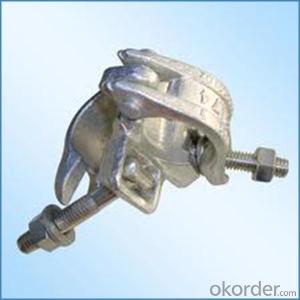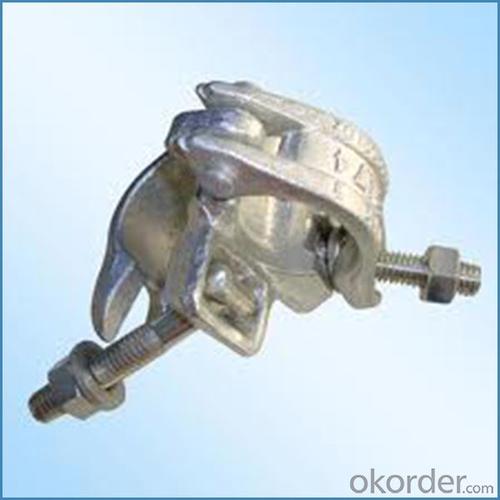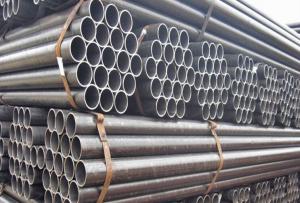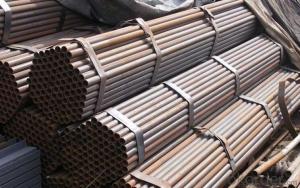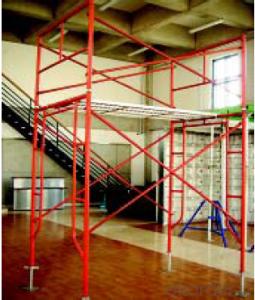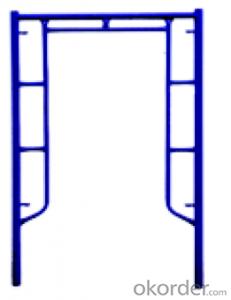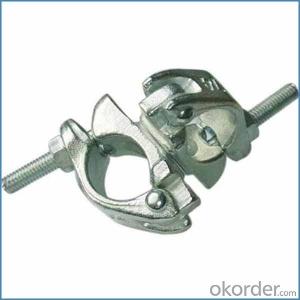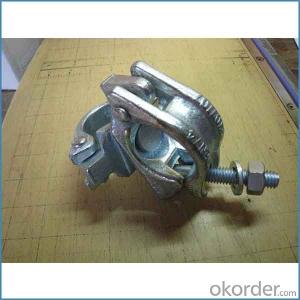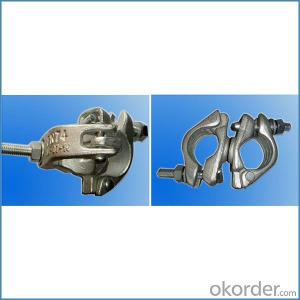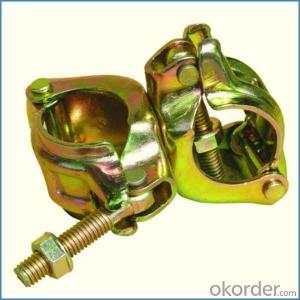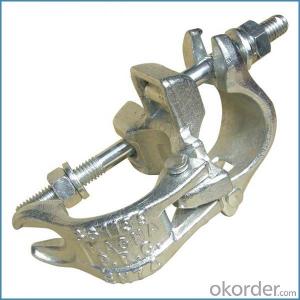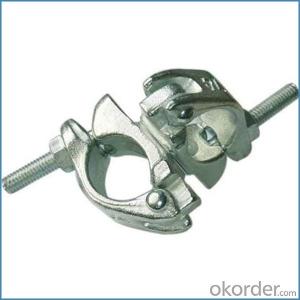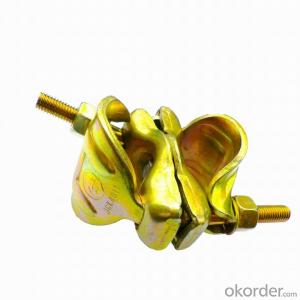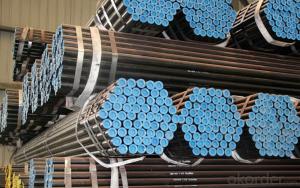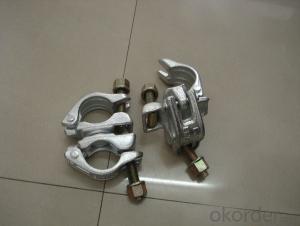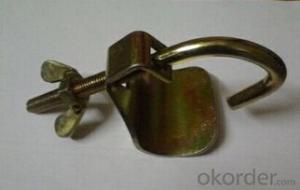Italian Swivel Coupler British Type for Sale
- Loading Port:
- Tianjin
- Payment Terms:
- TT OR LC
- Min Order Qty:
- 100 kg
- Supply Capability:
- 100000 kg/month
OKorder Service Pledge
OKorder Financial Service
You Might Also Like
Italian Swivel Coupler British Type
Description
1.The scaffolding coupler is always used to connect the steel pipe as scaffolding system.
2.The often used coupler is swivel coupler and righ angle coupler .
3.We can provide types of scaffolding coupler according to your requirement.
4.Couoler can fix the 48.3mm scaffolding steel pipe tightly and make the whole scaffolding system more steadily.
5.Material:Q235 steel
6.Overall Size:48.3mm*48.3mm
7.Surface Finish: Galvanized/ Painted
8.Standard:BS1139,EN74
9.Package:25pcs/bag
10.Manufactuering as per customer requirements
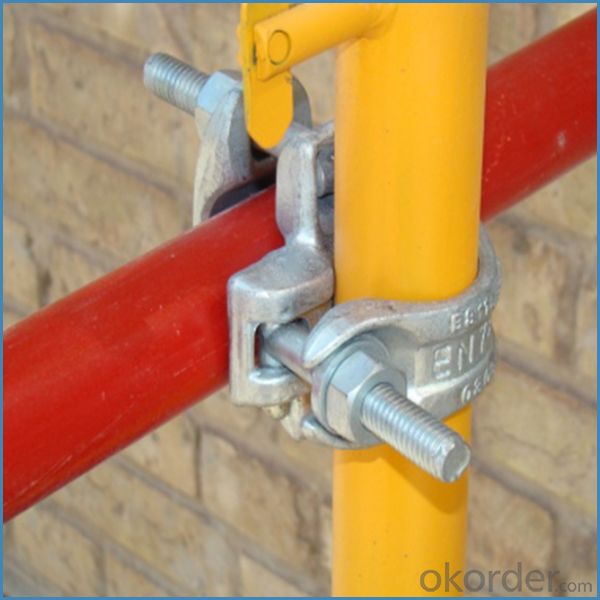
Feature
(1)Excellent Anti-Breaking—Cold Pressed Steel
(2)Outstanding Resistance Deformation
(3)Strong Anti-Dropping Ability
(4)Longtime USe
(5)Qualtity Guaranteed
(6)OEM Service
Photo

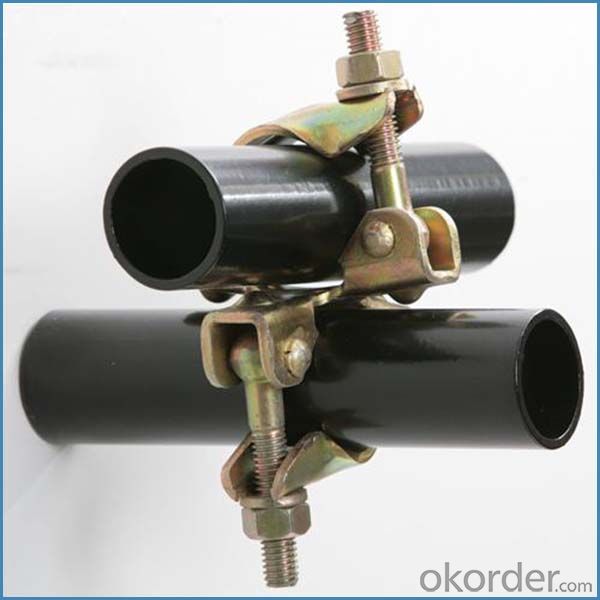
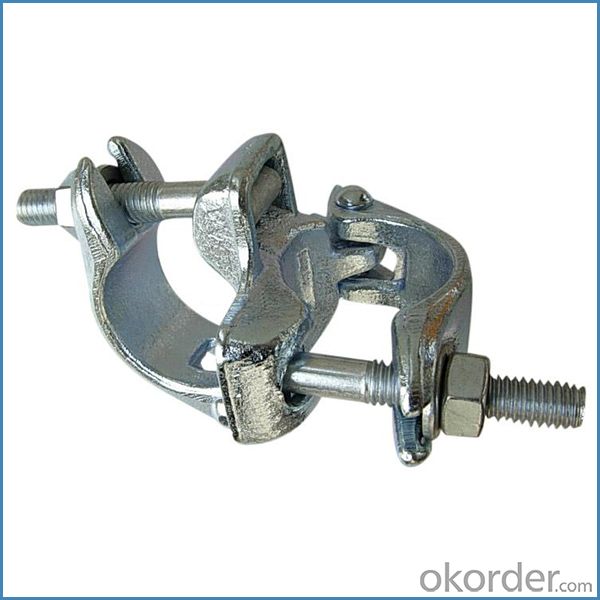
Parameter
| Material | Q235,345steel |
| Size | 48.3mm*48.3mm |
| Surface finish | Galvanized |
| Weight | 1.1kg around |
| Standard | BS1139,EN74 |
| Package | 25pcs/bag,steel pallet |
| Manufacture | As per customer requirement |
| Market | Africa, South America, the Middle East and Asia |
FAQ
Q: Are you a factory or trading company?
We are a state-owned corporation in China,dealing with various kinds of building materials.We have our holding subsidiaries.
Q: Where is your factory located? How can I visit there?
Our factory is located all around China.
Q: Can I get some samples?
Sample is free, customer only pay freight for the first time.
Q: Delivery?
10-30days. (5-15 containers)
Any question,feel free to contact us.
- Q: How do you ensure proper weight distribution when using steel tube couplers in scaffolding?
- Proper weight distribution when using steel tube couplers in scaffolding can be ensured by following a few key steps. Firstly, it is important to calculate and understand the weight-bearing capacity of each coupler being used. This information can usually be found in the manufacturer's guidelines or specifications. Secondly, when assembling the scaffolding, make sure that the load is evenly distributed across the couplers by placing the weight at regular intervals along the structure. Additionally, using appropriate bracing and diagonal supports can help to maintain stability and distribute the weight evenly. Regular inspections and maintenance of the scaffolding system are also crucial to identify any signs of imbalance or stress and address them promptly.
- Q: How do steel tube couplers prevent corrosion or deterioration of scaffolding connections over time?
- Steel tube couplers are designed to prevent corrosion or deterioration of scaffolding connections over time through a combination of material selection, design features, and protective measures. Firstly, steel tube couplers are typically made from high-quality, corrosion-resistant steel alloys such as galvanized or stainless steel. These alloys have inherent properties that make them resistant to rust and corrosion, even when exposed to harsh environmental conditions such as moisture, chemicals, or extreme temperatures. This ensures that the couplers remain structurally sound and maintain their integrity over time. Additionally, the design of steel tube couplers plays a crucial role in preventing corrosion or deterioration. These couplers are engineered to provide a tight and secure connection between scaffolding tubes, minimizing any gaps or openings that could allow moisture or other corrosive agents to penetrate the joint. By creating a sealed connection, the couplers effectively prevent the entry of water, oxygen, or other corrosive substances that could lead to rust or deterioration over time. Furthermore, steel tube couplers often incorporate protective measures to enhance their resistance to corrosion. One common protective measure is the application of a galvanized coating, which involves applying a layer of zinc to the surface of the coupler. This zinc coating provides an additional barrier against corrosion and acts as a sacrificial layer, meaning it corrodes before the underlying steel, further prolonging the lifespan of the coupler. Regular maintenance and inspection are also essential to prevent corrosion or deterioration of steel tube couplers and scaffolding connections. This includes inspecting the couplers for signs of damage or wear, addressing any areas with chipped or damaged coatings, and promptly replacing couplers that show signs of significant corrosion or structural compromise. In conclusion, steel tube couplers prevent corrosion or deterioration of scaffolding connections over time through the use of corrosion-resistant materials, tight and sealed connections, protective coatings, and regular maintenance. These measures ensure that couplers remain structurally sound and reliable throughout the lifespan of the scaffolding system, promoting safety and longevity in construction projects.
- Q: How do steel tube couplers contribute to the overall speed of a scaffolding project?
- The overall speed of a scaffolding project is enhanced by steel tube couplers in various ways. To begin with, they offer a rapid and effective method of connecting steel tubes together, eliminating the need for time-consuming welding or threading. This enables the scaffold structure to be assembled and disassembled quickly, saving valuable time on the project. In addition, steel tube couplers are specifically designed to establish a secure and stable connection between tubes, ensuring the structural soundness of the scaffolding. This eliminates the necessity for additional time-consuming reinforcement or bracing, as the couplers provide the essential strength and stability to support the scaffold. Moreover, the versatility of steel tube couplers permits easy adjustment and modification of the scaffold structure. Couplers can be effortlessly repositioned or replaced as required, allowing for swift alterations to the scaffold design. This flexibility helps to streamline the construction process and accommodate any changes or modifications that may arise during the project. Overall, the utilization of steel tube couplers in scaffolding projects significantly contributes to the speed and efficiency of the construction process. Their quick and secure connections, as well as their versatility and adaptability, aid in saving time and resources, enabling the project to be completed promptly.
- Q: Are steel tube couplers adjustable for different angles in scaffolding?
- Steel tube couplers are capable of being adjusted to different angles in scaffolding. Often known as scaffolding clamps or fittings, these versatile components connect scaffolding tubes together to create a secure and stable structure. Typically designed to be adjustable, these couplers allow for the achievement of various angles in scaffolding systems. Various types of steel tube couplers are available, including swivel couplers, putlog couplers, and sleeve couplers, which offer flexibility in angle adjustment. For instance, swivel couplers have a rotating mechanism that enables the connected tubes to be adjusted to different angles. Putlog couplers facilitate the connection of horizontal tubes at right angles to vertical tubes, accommodating different angles in the scaffolding structure. On the other hand, sleeve couplers allow for the end-to-end connection of two tubes, creating longer lengths or adjusting angles accordingly. These crucial adjustable steel tube couplers play a significant role in scaffolding systems, as they allow scaffolders to construct structures that meet specific project requirements, whether it be for straight vertical structures or curved and angled designs. The ability to adjust scaffolding angles using steel tube couplers ensures a safe and stable working platform for workers and promotes efficient construction projects.
- Q: How do you inspect steel tube couplers for any damages or defects?
- Inspecting steel tube couplers for damages or defects involves a systematic approach to ensure their structural integrity and functionality. Here are the steps to inspect steel tube couplers thoroughly: 1. Visual Inspection: Begin by visually examining the couplers for any visible damages or defects. Look for signs of cracks, dents, deformation, or corrosion on the surface. Pay close attention to areas around welds and connections. 2. Dimensional Verification: Measure the dimensions of the coupler using suitable tools such as calipers or micrometers. Compare the measurements with the manufacturer's specifications to ensure they fall within acceptable tolerances. 3. Non-Destructive Testing (NDT): Utilize non-destructive testing methods to detect any hidden defects that may not be visible to the naked eye. Common NDT techniques include ultrasonic testing, magnetic particle testing, or dye penetrant testing. These methods can identify cracks, internal flaws, or material inconsistencies. 4. Load Testing: Perform load tests on a representative sample of couplers to verify their load-carrying capacity. Apply a gradually increasing load to the coupler while monitoring for any signs of deformation, cracking, or failure. Ensure the load testing is conducted within the specified limits as per the relevant standards or regulations. 5. Documentation: Maintain detailed records of all inspections, including the date, inspector's name, findings, and any necessary actions taken. This documentation will serve as a reference for future inspections and provide an audit trail if needed. 6. Regular Maintenance: Implement a routine maintenance plan to inspect steel tube couplers periodically. This includes regular cleaning, lubrication, and re-inspection to identify any damages or defects that may have occurred during usage. It is essential to follow industry standards, manufacturer guidelines, and applicable regulations while inspecting steel tube couplers. If any significant damages or defects are detected, consult an expert or the manufacturer for guidance on repair or replacement.
- Q: Can steel tube couplers be used for suspended scaffolding systems?
- Yes, steel tube couplers can be used for suspended scaffolding systems. Steel tube couplers are commonly used in the construction industry to connect and secure steel tubes together, creating a rigid and stable structure. In the case of suspended scaffolding systems, steel tube couplers can be used to connect the various components of the system, such as the vertical tubes, horizontal tubes, and diagonal bracing, ensuring the overall stability and safety of the scaffolding. These couplers are designed to withstand heavy loads and provide a secure connection, making them suitable for use in suspended scaffolding systems where safety is paramount.
- Q: Are steel tube couplers easy to install and remove?
- Yes, steel tube couplers are relatively easy to install and remove. These couplers are designed to connect two or more steel tubes together, providing a secure and strong joint. They typically have a simple and straightforward installation process, requiring minimal tools and equipment. The couplers are usually threaded or have a slip-on design, allowing for quick and easy attachment to the steel tubes. Similarly, the removal process is also uncomplicated, often involving the use of a wrench or other tools to loosen the coupler and detach it from the tubes. Overall, steel tube couplers offer convenience and ease of use in both installation and removal processes.
- Q: Are steel tube couplers resistant to vibrations or dynamic loads in scaffolding applications?
- Steel tube couplers are widely recognized for their ability to resist vibrations and dynamic loads when used in scaffolding applications. Due to its exceptional strength and durability, steel is an excellent choice for couplers employed in scaffolding. These couplers are specifically designed to securely connect steel tubes, thus providing a stable and secure structure for workers. They are engineered to withstand a variety of forces, including vibrations and dynamic loads that may arise during construction activities. Furthermore, steel tube couplers are subjected to thorough testing and adhere to industry standards to guarantee their performance and safety. In conclusion, steel tube couplers are both dependable and efficient when it comes to withstanding vibrations and dynamic loads in scaffolding applications.
- Q: What are the advantages of using steel tube couplers over other types of couplers in scaffolding?
- There are several advantages to using steel tube couplers over other types of couplers in scaffolding. Firstly, steel tube couplers are known for their strength and durability. They are designed to withstand heavy loads and provide a secure connection between scaffolding tubes. This makes them ideal for construction projects that require a stable and reliable structure. Moreover, steel tube couplers are versatile and can be used in various configurations. They can be easily attached to different sizes of scaffolding tubes, allowing for flexibility when constructing scaffolding systems. This versatility makes them suitable for a wide range of applications and ensures compatibility with existing scaffolding equipment. Another advantage of steel tube couplers is their ease of use. They typically have a simple design that allows for quick and efficient installation. This saves time and effort during assembly and disassembly of scaffolding systems, improving overall productivity on the job site. Furthermore, steel tube couplers offer excellent resistance to corrosion. They are often galvanized or coated with protective materials to prevent rust and corrosion, ensuring their longevity in harsh environments. This corrosion resistance makes them a reliable choice for outdoor projects, especially in areas with high humidity or exposure to the elements. Lastly, steel tube couplers have a high load-bearing capacity. They can handle significant weight without compromising the stability of the scaffolding structure. This makes them suitable for heavy-duty construction projects that require scaffolding to support heavy equipment or materials. In summary, the advantages of using steel tube couplers in scaffolding include their strength, versatility, ease of use, resistance to corrosion, and high load-bearing capacity. These qualities make them a preferred choice for construction professionals looking for a reliable and durable coupler option.
- Q: How do you ensure proper alignment when connecting steel tube couplers in scaffolding?
- To ensure proper alignment when connecting steel tube couplers in scaffolding, it is important to follow these steps: 1. Start by cleaning the ends of the steel tubes and couplers to remove any dirt or debris that may hinder the connection. 2. Insert one end of the tube into the coupler and make sure it is fully engaged. The tube should go all the way into the coupler until it reaches the stopper. 3. Rotate the tube slightly to ensure it is properly aligned with the coupler. It should be straight and not at an angle. 4. Use a hammer or mallet to gently tap the tube into the coupler if needed. Be careful not to apply excessive force, as it may damage the tube or coupler. 5. Repeat the same process for the other end of the tube and coupler, ensuring proper alignment and full engagement. 6. Once both ends of the tube are connected to the couplers, double-check their alignment by visually inspecting the scaffolding structure. It should be straight, level, and securely connected. 7. Regularly inspect the scaffolding during use to ensure that the tube couplers remain properly aligned. If any misalignment or movement is noticed, it should be promptly addressed to maintain the safety and stability of the scaffolding structure.
Send your message to us
Italian Swivel Coupler British Type for Sale
- Loading Port:
- Tianjin
- Payment Terms:
- TT OR LC
- Min Order Qty:
- 100 kg
- Supply Capability:
- 100000 kg/month
OKorder Service Pledge
OKorder Financial Service
Similar products
Hot products
Hot Searches
Related keywords
